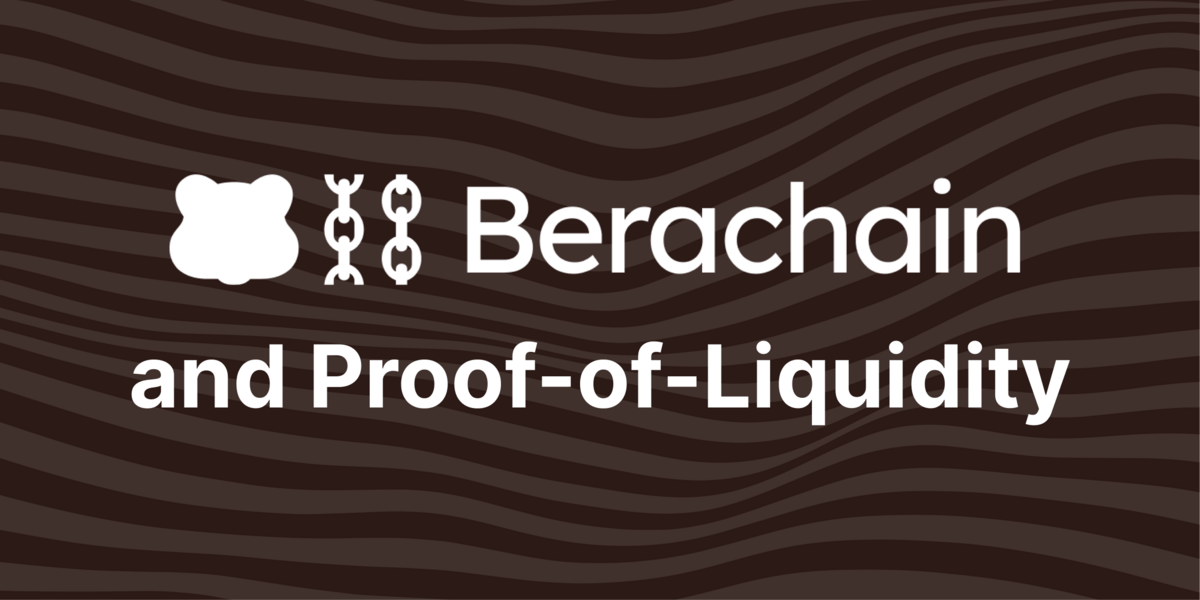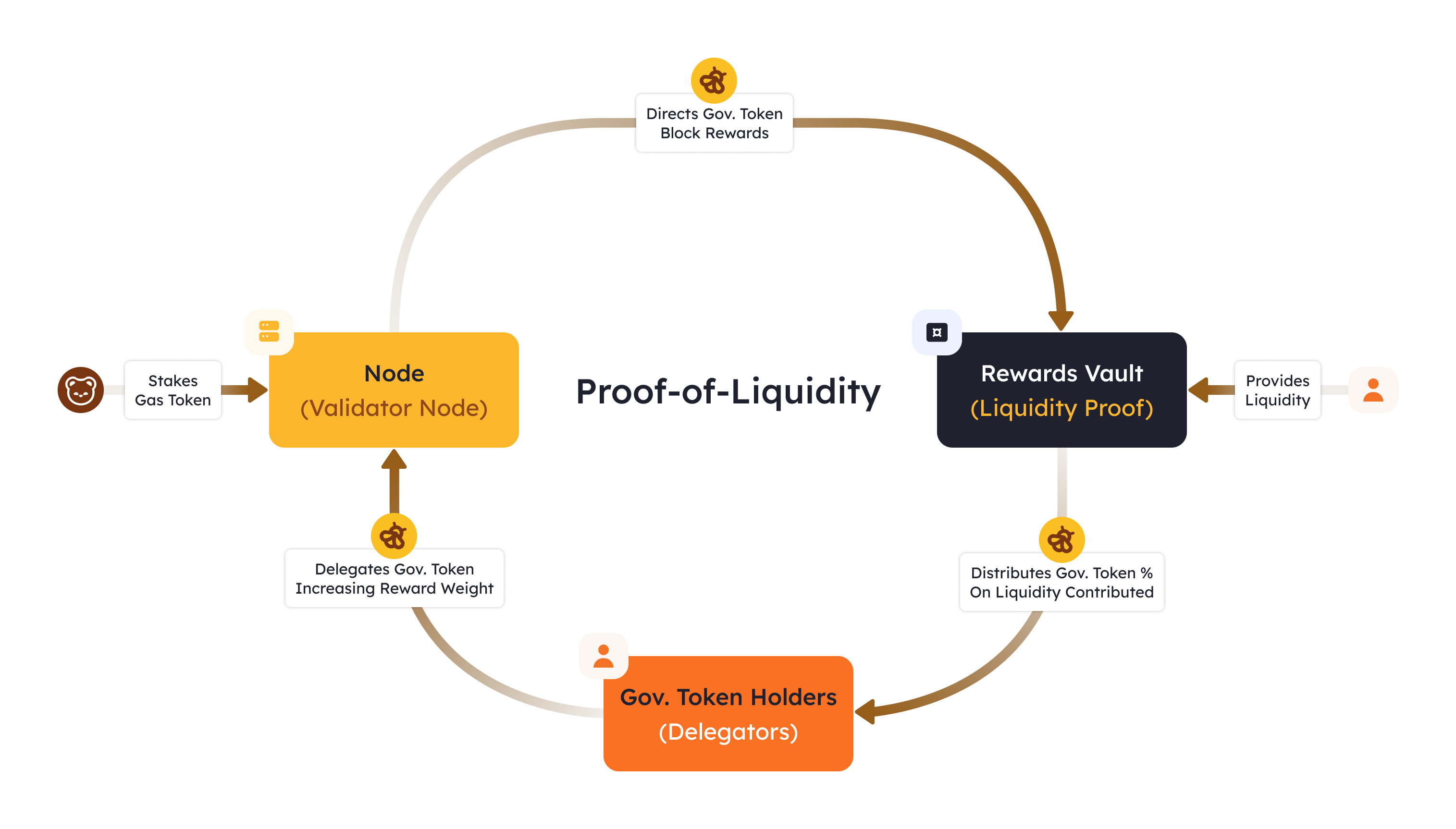Proof of Liquidity vs Proof of Stake
 Killua Zoldyck
Killua Zoldyck
Blockchain consensus mechanisms continue to evolve, pushing beyond traditional Proof of Stake (PoS) models. Berachain introduces a novel approach with its Proof of Liquidity (PoL) protocol, which not only secures the network but also integrates deeply with DeFi from day one.
While PoL shares PoS’s core principle of incentivizing security through economic stakes, it diverges fundamentally in execution—prioritizing active liquidity over idle collateral.
This article breaks down PoL’s mechanics, how it compares to PoS, and why it could reshape the future of decentralized networks.
What Is Proof of Stake (PoS)? A Quick Recap
Before diving into PoL, let’s establish a baseline with PoS, a consensus mechanism used by blockchains like Ethereum and Cosmos.
Mechanism: In PoS, validators lock up (stake) a certain amount of the blockchain’s native token (e.g., ETH) as collateral to participate in block validation and consensus.
Role: Validators propose and validate blocks, earning rewards—such as transaction fees or block rewards—proportional to their stake.
Penalties: Misbehavior, like double-signing or going offline, results in slashing, where a portion of the staked tokens is confiscated as punishment.
Purpose: PoS secures the network by tying economic incentives to honest behavior: the more you stake, the more influence you have, but also the more you risk losing.
PoS is straightforward: stake tokens, validate blocks, and face penalties for bad behavior. It’s battle-tested but has limitations—most notably, staked tokens often sit idle, contributing little to ecosystem liquidity or activity.
Introducing Berachain and Proof of Liquidity (PoL)
Berachain, a layer-1 blockchain, takes a different approach with Proof of Liquidity (PoL), a novel consensus mechanism that integrates network security with DeFi activity. Instead of focusing solely on staking for security, PoL incentivizes participants to provide liquidity to the ecosystem, aligning the incentives of network security with economic growth.
Core Tokens in Berachain
To understand PoL, we first need to know the three native tokens in Berachain’s ecosystem:
BERA: The gas token used to pay transaction fees on the network.
HONEY: A stablecoin pegged to the US dollar, used as a reliable medium of exchange in DeFi.
BGT (Bera Governance Token): A non-transferable governance token earned by providing liquidity; used for staking in consensus and directing emissions to DeFi protocols.
These tokens work together to create a symbiotic relationship between liquidity provision and network security.
How Proof of Liquidity Works
PoL flips the traditional PoS model by emphasizing active economic participation over passive token locking. Here’s a breakdown of its mechanics:
Mechanism: Participants (users and validators) provide liquidity to the ecosystem—typically by depositing assets into liquidity pools on BEX (Berachain’s native decentralized exchange). This liquidity powers DeFi protocols and earns participants BGT rewards.
Roles:
Users: Deposit assets (e.g., BERA, HONEY, or other tokens) into approved liquidity pools to earn BGT. They don’t validate blocks directly but contribute to the network’s economic activity.
Validators: Stake BGT (earned from liquidity or delegated by users) to participate in consensus and block validation, similar to PoS. Validators also direct BGT emissions to specific protocols, incentivizing liquidity where it’s needed.
Purpose: PoL secures the network by tying security to liquidity. Instead of idle token staking, it rewards active DeFi participation.
Penalties: Malicious validator behavior (e.g., double-signing) results in slashing of their staked BGT, much like PoS. However, the deposited liquidity (e.g., assets in pools) isn’t directly slashed—it’s the BGT earned from that liquidity that’s at risk when staked with validators.

Key differences Between PoS and PoL
While PoL and PoS share some surface-level similarities, they diverge in their core mechanics and goals. Here’s a detailed comparison addressing deposits, penalties, and the concept of staking:
What’s Deposited?
PoS: Validators deposit (stake) the native token (e.g., ETH) directly into the consensus mechanism to secure the chain.
PoL: Users deposit assets (e.g., BERA, HONEY, or other tokens) into liquidity pools to earn BGT. Validators then stake this BGT (not the original assets) for consensus. The "deposit" is more about providing liquidity to DeFi than locking tokens for security alone.
What’s Penalized?
PoS: Malicious validators lose a portion of their staked tokens (e.g., ETH slashed).
PoL: While PoL doesn’t directly slash liquidity deposits, validators who misbehave lose their staked BGT. This indirectly impacts liquidity providers since slashed validators are less likely to direct future emissions to their pools, reducing their BGT earnings.
Is It the Same as Staking?
Similarities: Both involve locking up value (tokens in PoS, liquidity in PoL) to support the network, and both penalize bad actors via slashing. Validators in PoL still "stake" BGT, much like PoS validators stake tokens.
Differences: PoL’s "staking" is indirect—users provide liquidity to earn BGT, which validators then stake. PoS focuses on security through idle token locking, while PoL emphasizes active economic participation (liquidity provision) to drive ecosystem growth. In PoS, staking is the end goal; in PoL, staking BGT is a byproduct of liquidity provision.
Why Isn’t PoL Just PoS with Extra Steps?
While PoL feels like "staking with a twist," its design solves a different problem:
PoS Pain Point: In traditional PoS, staked tokens are locked and illiquid, often sitting idle rather than fueling ecosystem activity.
New chains struggle with liquidity early on (the "cold start problem")
- PoL Solution: By tying consensus to liquidity provision, PoL ensures tokens are actively used in DeFi (e.g., trading, lending) from day one. Validators don’t just secure the chain—they amplify liquidity by directing BGT rewards to protocols, creating a self-reinforcing cycle.
Think of it this way:
PoS = "Stake tokens to secure the network."
PoL = "Provide liquidity to grow the ecosystem, earn governance power, and let validators secure the network with it."
Example to Clarify
Let’s contrast PoS and PoL with a practical scenario:
PoS: You stake 32 ETH to run an Ethereum validator. If you double-sign, you lose some ETH.
PoL: You deposit 100 BERA and 100 HONEY into a BEX pool, earning 50 BGT. You delegate that BGT to a validator. If the validator misbehaves, their staked BGT (including yours) gets slashed, but your 100 BERA and 100 HONEY in the pool remain safe (though you might lose future BGT rewards).
This example highlights a key distinction: in PoL, the assets you deposit into liquidity pools are not directly at risk for validator misbehavior—only the BGT earned from those assets is.
Technical Deep Dive: How PoL Integrates with Berachain’s Architecture
To appreciate PoL’s innovation, it’s worth understanding how it fits into Berachain’s broader architecture:
The Role of BGT Emissions
BGT emissions are controlled by validators and governance. Validators can vote to direct BGT rewards to specific liquidity pools or protocols, incentivizing users to provide liquidity where it’s most needed.
This creates a feedback loop: more liquidity leads to more BGT, which leads to more staking and better security, which in turn supports more DeFi activity.
Liquidity as a Security Primitive
In PoS, security comes from the value of staked tokens—if the stake is high, the cost of attacking the network is high.
In PoL, security comes from both staked BGT and the liquidity backing the ecosystem. A liquid ecosystem makes BGT valuable (since it governs liquidity incentives), which in turn makes the network harder to attack.
Validator Incentives and Governance
- Validators in PoL don’t just validate blocks—they act as stewards of the ecosystem, deciding where to allocate BGT emissions. This dual role makes PoL more dynamic than PoS, as validators have a direct hand in shaping DeFi activity.
Benefits of Proof of Liquidity
PoL offers several advantages over traditional PoS, especially for a layer-1 blockchain aiming to compete in the crowded DeFi space:
Solves the Cold Start Problem:
- New blockchains often struggle with liquidity in their early days. PoL ensures that liquidity provision is baked into the consensus mechanism, encouraging users to participate in DeFi from the outset.
Active Participation Over Passive Staking:
- Unlike PoS, where tokens are often locked and idle, PoL encourages tokens to be used actively in liquidity pools, driving trading, lending, and other DeFi activities.
Decentralized Incentive Alignment:
- Validators and users are aligned through BGT: users provide liquidity to earn BGT, validators stake BGT to secure the network and direct rewards, creating a symbiotic relationship.
Enhanced Ecosystem Growth:
- By tying consensus to liquidity, PoL ensures that the network’s growth in security (via staking BGT) correlates with growth in economic activity (via liquidity provision).
Challenges and Risks of PoL
No system is perfect, and PoL introduces some unique challenges:
Complexity:
- PoL is more complex than PoS, with multiple steps (provide liquidity, earn BGT, delegate/stake BGT). This could deter less technical users or create confusion.
Liquidity Risks:
- Providing liquidity in DeFi pools often involves risks like impermanent loss. Users might lose value on their deposited assets even if they earn BGT rewards.
BGT Valuation:
- Since BGT is non-transferable and only used for staking and governance, its value depends heavily on the ecosystem’s success. If Berachain’s DeFi protocols fail to attract users, BGT’s utility could diminish, weakening network security.
Validator Centralization:
- If a few validators accumulate large amounts of delegated BGT, they could dominate both consensus and liquidity incentives, potentially leading to centralization risks.
PoL in the Broader Blockchain Landscape
How does PoL stack up against other consensus mechanisms beyond PoS?
Proof of Work (PoW):
- PoW (e.g., Bitcoin) relies on computational power, which is energy-intensive and doesn’t contribute to ecosystem liquidity. PoL, like PoS, is more energy-efficient and focuses on economic incentives over raw computation.
Delegated Proof of Stake (DPoS):
- DPoS (e.g., EOS) involves token holders voting for delegates to validate blocks. PoL’s delegation of BGT to validators is similar, but PoL adds the layer of liquidity provision, making it more DeFi-centric.
Other Liquidity-Focused Mechanisms:
- Protocols like Osmosis (in the Cosmos ecosystem) incentivize liquidity provision through staking rewards, but they don’t tie it directly to consensus like PoL does. PoL’s integration of liquidity into the security model is unique.
Conclusion
Proof of Liquidity isn’t exactly the same as staking in PoS—it’s a hybrid that blends staking with liquidity provision. The deposited funds (liquidity) aren’t directly penalized like staked tokens in PoS; instead, the penalty hits the BGT earned from that liquidity. This shift makes PoL less about passive token locking and more about active ecosystem participation, setting Berachain apart from typical PoS chains.
By solving the cold start problem and aligning network security with DeFi activity, PoL offers a fresh approach to consensus design.
While it introduces new complexities and risks, its potential to create a self-sustaining, liquid ecosystem is undeniable. As Berachain matures, PoL could redefine how we think about the intersection of consensus and decentralized finance, paving the way for a new generation of layer-1 blockchains.
References
- Proof of Liquidity Overview: Berachain Blog
Subscribe to my newsletter
Read articles from Killua Zoldyck directly inside your inbox. Subscribe to the newsletter, and don't miss out.
Written by

Killua Zoldyck
Killua Zoldyck
Sick of writing Bio s everywhere.